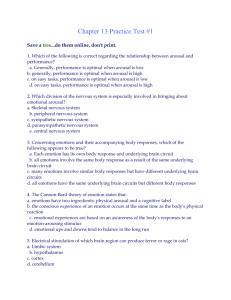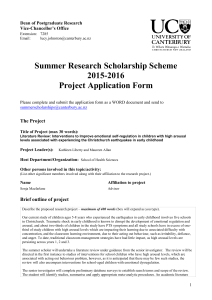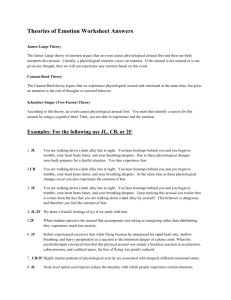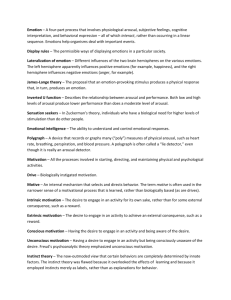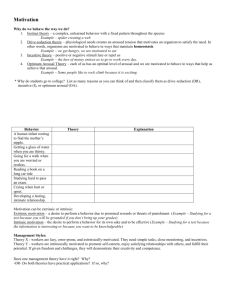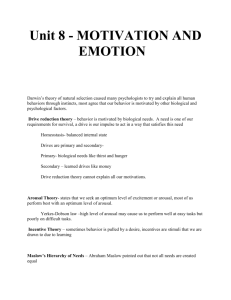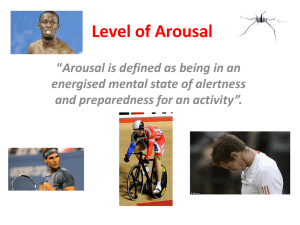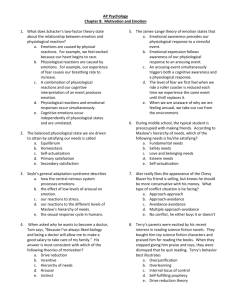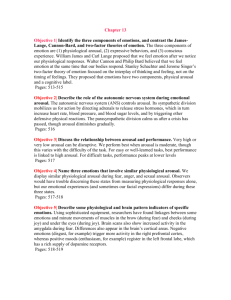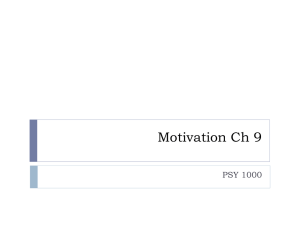Emot Practice Test2
advertisement
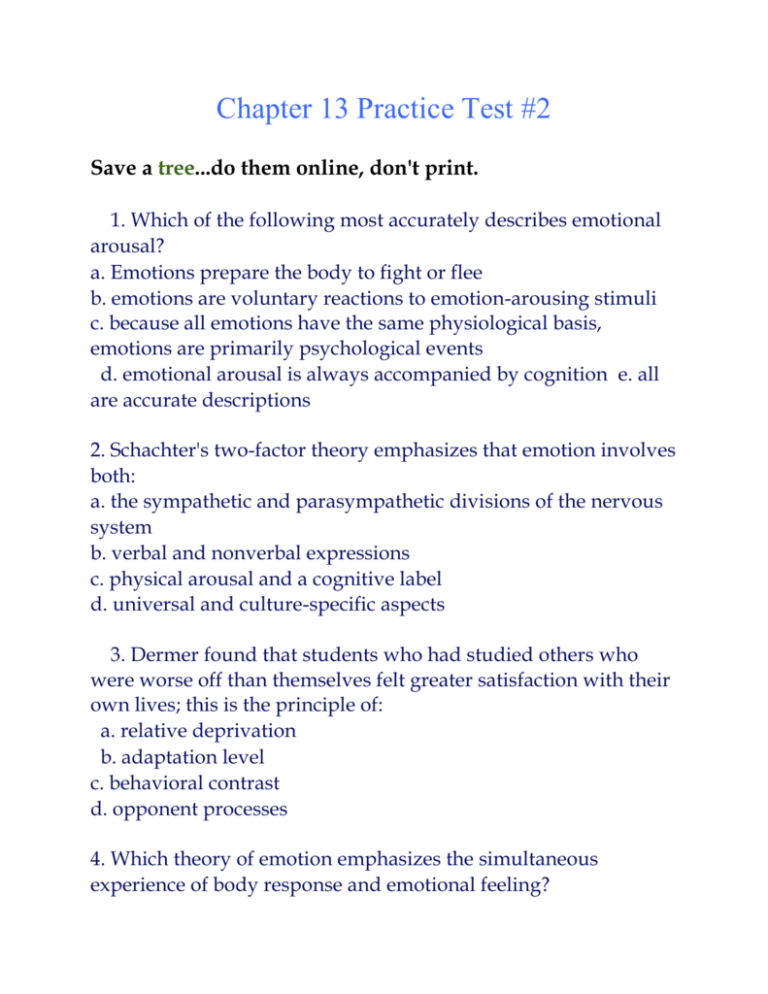
Chapter 13 Practice Test #2 Save a tree...do them online, don't print. 1. Which of the following most accurately describes emotional arousal? a. Emotions prepare the body to fight or flee b. emotions are voluntary reactions to emotion-arousing stimuli c. because all emotions have the same physiological basis, emotions are primarily psychological events d. emotional arousal is always accompanied by cognition e. all are accurate descriptions 2. Schachter's two-factor theory emphasizes that emotion involves both: a. the sympathetic and parasympathetic divisions of the nervous system b. verbal and nonverbal expressions c. physical arousal and a cognitive label d. universal and culture-specific aspects 3. Dermer found that students who had studied others who were worse off than themselves felt greater satisfaction with their own lives; this is the principle of: a. relative deprivation b. adaptation level c. behavioral contrast d. opponent processes 4. Which theory of emotion emphasizes the simultaneous experience of body response and emotional feeling? a. James-Lange theory b. Cannon-Bard theory c. two-factor theory d. opponent-process theory 5. Izard believes that there are _______ basic emotions a. 3 b. 5 c. 7 d. 10 e. 12 6. (Thinking Critically) The polygraph measures: a. lying b. brain rhythms c. chemical changes in the body d. physiological indexes of arousal 8. Which of the following is true? a. Gestures are universal; facial expressions, culture-specific b. facial expressions are universal; gestures, culture-specific c. both gestures and facial expressions are universal d. both gestures and facial expressions are culture-specific 9. Which theory of emotion implies that every emotion is associated with a unique physiological reaction? a. James-Lange theory b. Cannon-Bard theory c. two-factor theory d. opponent-process theory 10. For which of the following fears do humans appear to be biologically prepared? a. Fear of electricity b. fear of cliffs c. fear of flowers d. fear of flying e. fear of bombs 11. Which of the following was not presented in the text as evidence that some emotional reactions involve no deliberate, rational thinking? a. Some of the neural pathways involved in emotion are separate from those involved in thinking and memory b. emotional reactions are sometimes quicker than our interpretations of a situation c. people can develop an emotional preference for visual stimuli to which they have been unknowingly exposed d. arousal of the sympathetic nervous system will trigger an emotional reaction even when artificially induced by an injection of epinephrine 12. Concerning the catharsis hypothesis, which of the following is true? a. Expressing anger can be temporarily calming if it does not leave one feeling guilty or anxious b. the arousal that accompanies unexpressed anger never dissipates c. expressing one's anger always calms one down d. psychologists agree that under no circumstances is catharsis beneficial 13. In an emergency situation, emotional arousal will result in: a. increased rate of respiration b. increased blood sugar c. a slowing of digestion d. pupil dilation e. all of the above 14. A relatively high level of arousal would be most likely to facilitate: a. remembering the lines of a play b. shooting free throws in a basketball c. sprinting 100 meters d. taking a final exam in introductory psychology 15. Several studies have shown that physical arousal can intensify just about any emotion. For example, when people who have been physically aroused by exercise are insulted, they often misattribute their arousal to the insult. This finding illustrates the importance of: a. cognitive labels of arousal in the conscious experience of emotions b. a minimum level of arousal in triggering emotional experiences c. the simultaneous occurrence of physical arousal and cognitive labeling in emotional experience d. all of the above 16.(Thinking Critically) Psychologist David Lykkem is opposed to the use of lie detectors because: a. they represent an invasion of a person's privacy and could easily be used for unethical purposes b. there are often serious discrepancies among the various indicators such as perspiration and heart rate c. polygraphs cannot distinguish the various possible causes of arousal d. they are accurate only about 50 percent of the time 17. Most human fears are: a. universal b. biologically determined c. present at birth d. learned 18. Averill found that most people become angry: a. once a day b. once a week c. several times a week d. several times a month e. there is no common pattern to anger 19. Which of these factors have researchers not found to correlate with happiness? a. A satisfying marriage or close friendship b. high self-esteem c. religious faith d. intelligence 20. In cultures that emphasize social interdependence: a. emotional displays are typically intense b. emotional displays are typically prolonged c. negative emotions are rarely displayed d. all of the above are true Answers 1. A 2. C 3. A 4. B 5. D 6. D 7. No Question 8. B 9. A 10 B 11. D 12. A 13. E 14. C 15. A 16. C 17. D 18. C 19. D 20. C
